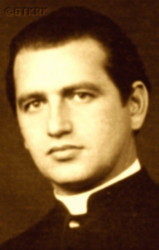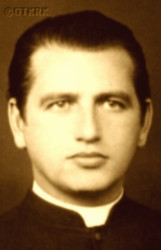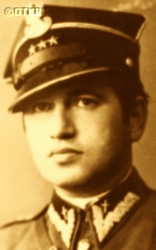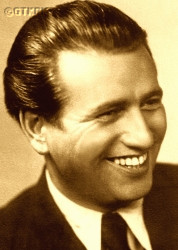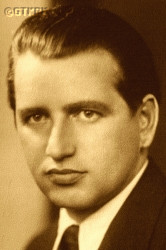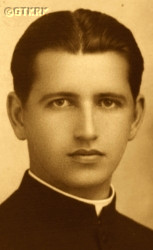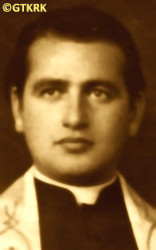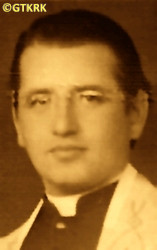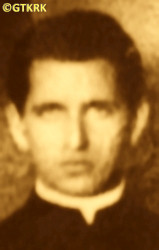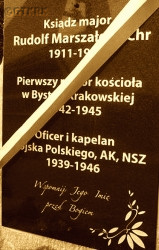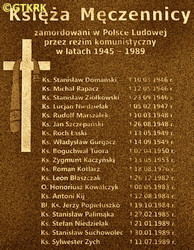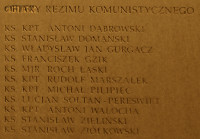Roman Catholic
St Sigismund parish
05-507 Słomczyn
85 Wiślana Str.
Konstancin deanery
Warsaw archdiocese, Poland
full list:
displayClick to display full list

searchClick to search full list by categories
wyświetlKliknij by wyświetlić pełną listę po polsku

szukajKliknij by przeszukać listę wg kategorii po polsku

Martyrology of the clergy — Poland
XX century (1914 – 1989)
personal data
surname
MARSZAŁEK
forename(s)
Rudolph (pl. Rudolf)
function
religious cleric
creed
Latin (Roman Catholic) Church RCmore on
en.wikipedia.org
[access: 2014.09.21]
congregation
Society of Christ Fathers for Poles Living Abroad SChrmore on
en.wikipedia.org
[access: 2013.05.19]
(i.e. Christ Fathers)
diocese / province
Katowice diocesemore on
en.wikipedia.org
[access: 2013.05.19]
Cracow archdiocesemore on
en.wikipedia.org
[access: 2013.05.19]
RC Military Ordinariate of Polandmore on
en.wikipedia.org
[access: 2014.12.20]
date and place
of death
10.03.1948

Warsawtoday: Warsaw city pov., Masovia voiv., Poland
more on
en.wikipedia.org
[access: 2021.10.09]
details of death
After secondary school graduation in 1931 student of the Infantry Cadets School in Zambrów.
After completion — as a corporal with census — an apprentice in the 4th Podhale Riflemen Regiment in Cieszyn.
On graduation made platoon cadet.
Next assigned to the 3rd Podhale Riflemen Regiment in Bielsko.
In 1932 transferred to the reserves in the rank of second lieutenant.
In 07.1939 drafted into Polish Army as a chaplain.
After German invasion of Poland on 01.09.1939 (Russians invaded Poland 17 days later) and start of the World War II participated in Warsaw defense as chaplain — hospital priest — of 58th Infantry Regiment of Greater Poland Army.
On 01.10.1939, after fall of the capital, arrested by the Germans.
Jailed in Pawiak prison in Warsaw but in 11.1939 released.
Next sent by the emerging Polish clandestine resistance leadership to native Bielsko.
Became chaplain to a clandestine resistance Polish military organisation „White Eagle” in Bielsk (part of Polish Clandestine State, just forming), nom‐de‐guerre „Rock”.
Exposed attempted to cross over to Polish troops in the West but on 04.04.1940 arrested on Polish–Hungarian border.
Jailed in Vienna.
Next till 03.1941 held in KL Gusen I concentration camp — part of KL Mauthausen‐Gusen concentration camps' complex — where slaved in quarries.
Thanks to prob. his family intervention from there taken back to Vienna and sentenced — as a „citizen of Germany” (his homeland was directly incorporated into Germany–proper by the German occupier) — to 1 year in prison, including period of incarceration.
After release returned in 06.1943 to Bielsko.
Became chaplain to a clandestine resistance Peasants Battalions BCh in Silesian Cieszyn region and next chaplain to clandestine resistance National Armed Forces NSZ.
After end of German occupation became chaplain of 13th Infantry Division of Polish troops in Russian army.
Few months later left — was already wanted by the Commie‐Nazi UB — and on 13.09.1945 clandestinely reached Munich and Germany through Cieszyn, Czech Prague, Regensburg and Nuremberg, where ministered to Polish soldiers in the West — served as chaplain to the NSZ's „Świętokrzyska Brigade” units, in major rank.
On 02.12.1945 returned to Russian occupied Poland and became parish priest in Bystra Mikuszowice.
In danger of imminent arrest by Commie‐Nazi UB, Polish branch of Russian NKVD on 01.07.1946 went into hiding in Górny Szczyrk.
Became chaplain to the resistance partisan „Bartek” unit of clandestine Polish National Army NSZ.
In 10‐11.1946 again crossed over to the West.
After return on 13.12.1946 prob. with an order to Polish clandestine units to disband and demobilize arrested by the Commie‐Nazi UB.
After a month in Silesian prisons jailed in Warsaw Mokotów Rakowiecka Str. prison.
Tortured.
On 14.01.1948 tried at a summary court and 3 days later received four death sentences.
His application for the „prerogative of mercy” was on 07.03.1948 rejected by Mr Boleslav Bierut (Polish traitor, in 1945 Russian governor in occupied Poland, earlier in 1923 as a Russian spy exchanged for Catholic bishop Cieplak sentenced by Russians to death).
3 days later murdered in prison.
cause of death
murder
perpetrators
Russians / Poles
sites and events
Warsaw (Mokotów)Click to display the description, ViennaClick to display the description, KL Gusen IClick to display the description, KL Mauthausen‐GusenClick to display the description, PawiakClick to display the description, «Intelligenzaktion»Click to display the description, UWZL Potulitz (Lebrechtsdorf)Click to display the description, Ribbentrop‐MolotovClick to display the description, Pius XI's encyclicalsClick to display the description
date and place
of birth
29.08.1911

Komorowice Krakowskietoday: part of Bielsko‐Biała, Bielsko‐Biała city pov., Silesia voiv., Poland
more on
en.wikipedia.org
[access: 2022.01.28]
parents
MARSZAŁEK John
🞲 ?, ? — 🕆 ?, ?

BACHOWSKA Therese
🞲 ?, ? — 🕆 ?, ?
religious vows
13.10.1934 (temporary)
22.10.1937 (permanent)
presbyter (holy orders)
ordination
03.06.1939

Poznańtoday: Poznań city pov., Greater Poland voiv., Poland
more on
en.wikipedia.org
[access: 2021.07.18]
St Peter and St Paul the Apostles RC archcathedral churchmore on
en.wikipedia.org
[access: 2025.03.14]
positions held
1942 – 1946
curatus/rector/expositus — Bystraform.: Bystra Śląska and Bystra Katowicka
today: Wilkowice gm., Bielsko‐Biała pov., Silesia voiv., Poland
more on
en.wikipedia.org
[access: 2022.05.23] ⋄ RC chapel (public) ⋄ Wilkowicetoday: Wilkowice gm., Bielsko‐Biała pov., Silesia voiv., Poland
more on
en.wikipedia.org
[access: 2021.12.18], St Michael the Archangel RC parish ⋄ Biała Krakowskatoday: district of Bielsko‐Biała, Bielsko‐Biała city pov., Silesia voiv., Poland
more on
en.wikipedia.org
[access: 2021.12.18] RC deanery
1942
curatus/rector/expositus — Dziedzicetoday: neighborhood in Czechowice‐Dziedzice, Czechowice‐Dziedzice gm., Bielsko‐Biała pov., Silesia voiv., Poland
more on
pl.wikipedia.org
[access: 2021.12.19] ⋄ Blessed Virgin Mary Queen of Poland RC church ⋄ Blessed Virgin Mary Help of Christians RC parish ⋄ Bielskotoday: part of Bielsko‐Biała, Bielsko‐Biała city pov., Silesia voiv., Poland
more on
en.wikipedia.org
[access: 2021.12.18] RC deanery
1941 – 1942
priest — Bielskotoday: part of Bielsko‐Biała, Bielsko‐Biała city pov., Silesia voiv., Poland
more on
en.wikipedia.org
[access: 2021.12.18] ⋄ St Nicholas the Bishop and Confessor RC parish ⋄ Bielskotoday: part of Bielsko‐Biała, Bielsko‐Biała city pov., Silesia voiv., Poland
more on
en.wikipedia.org
[access: 2021.12.18] RC deanery
till 1939
student — Poznańtoday: Poznań city pov., Greater Poland voiv., Poland
more on
en.wikipedia.org
[access: 2021.07.18] ⋄ theology, Archbishop's Theological Seminary (Collegium Leoninum) — residing in the Society's „House of Theological Studies”
from 1934
student — Gnieznotoday: Gniezno urban gm., Gniezno pov., Greater Poland voiv., Poland
more on
en.wikipedia.org
[access: 2021.12.18] ⋄ philosophy, Archbishop's Theological Seminary — residing in the Society's „House of Philosophical Studies”
1933 – 13.10.1934
novitiate — Potulicetoday: Nakło nad Notecią gm., Nakło nad Notecią pov., Kuyavia‐Pomerania voiv., Poland
more on
en.wikipedia.org
[access: 2021.07.18] ⋄ Motherhouse, Christ Fathers SChr
05.10.1933
friar — Potulicetoday: Nakło nad Notecią gm., Nakło nad Notecią pov., Kuyavia‐Pomerania voiv., Poland
more on
en.wikipedia.org
[access: 2021.07.18] ⋄ Motherhouse, Christ Fathers SChr
sites and events
descriptions
Warsaw (Mokotów): Prison and detention centre in Warsaw on Rakowiecka Str. Used by Germans during German occupation 1939‐1945 to held thousands of Poles. In 1945‐1956 thousands of Polish independence activists were held there by the Polish Commie‐Nazi branch of Russian NKVD/KGB police. Hundreds of Poles were executed. (more on: pl.wikipedia.orgClick to attempt to display webpage
[access: 2013.08.17])
Vienna: German penal prison.
KL Gusen I: German Germ. Konzentrationslager (Eng. concentration camp) KL „Grade III” (Germ. „Stufe III”), part of KL Mauthausen‐Gusen complex, intended for the „Incorrigible political enemies of the Reich”. The prisoners slaved at a nearby granite quarry, but also in local private companies: at SS guards houses' construction at a nearby Sankt Georgen for instance. Initially opened in 05.1940 as the „camp for Poles”, captured during the program of extermination of Polish intelligentsia («Intelligenzaktion»). Till the end most of the prisoners were Poles. Many Polish priests from the Polish regions incorporated in the Germany were brought there in 1940, after start of German occupation of Poland, from KL Sachsenhausen and KL Dachau concentration camps. (more on: en.wikipedia.orgClick to attempt to display webpage
[access: 2014.03.10])
KL Mauthausen‐Gusen: A large group of German Germ. Konzentrationslager (Eng. concentration camp) KL camps set up around the villages of Mauthausen and Gusen in Upper Austria, c. 30 km east of Linz, operational from 1938 till 05.1945. Over time it became of the largest labour camp complexes in the German‐controlled part of Europe encompassing four major camps concentration camps (KL Mauthausen, KL Gusen I, KL Gusen II and KL Gusen III) and more than 50 sub‐camps where inmates slaved in quarries — the granite extracted, previously used to pave the streets of Vienna, was intended for a complete reconstruction of major German towns according to the plans of the chief architect of National Socialist Germany, the Germ. Generalbauinspektor für die Reichshauptstadt (Eng. General Building Inspector for the Reich Capital) and from 1942 also, i.a. the Germ. Reichsminister für Bewaffnung und Munition (Eng. Reich Minister for Armaments and Ammunition), Albert Speer — munitions factories, mines, arms factories and Me 262 fighter‐plane assembly plants. The complex served the needs of the German war machine and also carried out extermination through labour. Initially did not have a its own gas chamber and the intended victims were mostly moved to the infamous euthanasia center in the Schloss Hartheim castle w Alkoven, 40.7 km east, or killed by lethal injection and cremated in the local crematorium. Later a van with the exhaust pipe connected to the inside shuttled between KL Mauthausen and KL Gusen. In 12.1941 a permanent gas chamber was built. C. 122,000‐360,000 of prisoners perished. Many Polish priests were held, including those captured during the program of extermination of Polish intelligentsia («Intelligenzaktion»). The camp complex was founded and run as a source for cheap labour for private enterprise. (more on: en.wikipedia.orgClick to attempt to display webpage
[access: 2014.03.10])
Pawiak: Investigative prison in Warsaw, built by the Russian occupiers of Poland in 1830‐1835. During the Poland partition's period, a Russian investigative prison, both criminal and political. During World War II and the German occupation, the largest German prison in the Germ. Generalgouvernement (Eng. General Governorate). Initially, it was subordinate to the Justice Department of the General Governorate, and from 03.1940 Germ. Sicherheitspolizei und des Sicherheitsdienst (Eng. Security Police and Security Service) of the Warsaw District — in particular the German Secret Political Police Gestapo. c. 3,000 prisoners were kept in Pawiak permanently, of which about 2,200 in the men's unit and c. 800 in the women's unit (the so‐called Serbia) — with a „capacity” of c. 1,000 prisoners. In total, in the years 1939‐1944, c. 100,000 Poles passed through the prison, of which c. 37,000 were murdered in executions — from 10.1943 Pawiak prisoners were murdered in open executions on the streets of Warsaw (sometimes several times a day) — during interrogations, in cells or in a prison „hospital”, and c. 60,000 were taken in 95 transports to concentration camps (mainly KL Auischwitz), other places of isolation or to forced labor. The prison Germans demolished during the Warsaw Uprising in 08‐10.1944. (more on: en.wikipedia.orgClick to attempt to display webpage
[access: 2022.08.17])
«Intelligenzaktion»: German: «Intelligenzaktion» (English: „Intelligence Action”) — a German program of extermination of the Polish elite, mainly the intelligentsia and leadership layers, carried out from the beginning of the occupation in w 09.1939 to 04.1940, mainly in territories directly annexed to Germany, but also in the so‐called Germ. Generalgouvernement (Eng. General Governorate), where it was called «AB‐aktion». In the first phase, immediately after the beginning of the German occupation, during military operations carried out by the Germ. Wehrmacht (Eng. Armed Forces) and the genocidal units of the Germ. Einsatzgruppen (Eng. Operational Groups) of the Germ. Sicherheitspolizei (Eng. Security Police), i.e. SiPo, and Germ. Sicherheitsdienst des Reichsführers SS (Eng. Security Service of the Reichsführer SS), i.e. SD, organized by the Germ. Reichssicherheitshauptamt (Eng. Reich Main Security Office), i.e. RSHA, which followed the troops, carried out under the Germ. Unternehmen „Tannenberg” (Eng. Operation „Tannenberg”) — based on the so‐called Germ. Sonderfahndungsliste (Eng. Special Wanted Lists), i.e. proscription lists of Poles considered particularly dangerous to the Third Reich, prepared by the Zentralstelle II/P (Polen) unit of the German RSHA. Later, implemented by the German civilian occupation authorities and the genocidal unit of the Germ. Volksdeutscher Selbstschutz (Eng. Ethnic Germans Self‐Defense), whose members were Germ. Volksdeutsche (Eng. Ethnic Germans), i.e. representatives of the German minority in Poland. According to various sources, these lists, at the beginning of 09.1939, could have contained the details of 61,000—88,000 „dangerous” Poles — although these figures cannot be confirmed. In total, during this genocide, c. 50,000 teachers, Catholic priests, representatives of the landed gentry, freelancers, social and political activists, and retired military personnel were systematically and methodically murdered. Another 50,000 were sent to concentration camps, where only a negligible percentage survived. (more on: en.wikipedia.orgClick to attempt to display webpage
[access: 2014.10.04])
UWZL Potulitz (Lebrechtsdorf): In the fall of 1939, after invasion of Poland the Germans — i.e. „East” branch of Treuhandanstalt, Main Trust Office — took over the Society of Christ Fathers for Poles Living Abroad Congregation’s house in Potulice, following eviction of all remaining friars. Initially the SS non‐commissioned officer's school was set up. In 1940, the estate was taken over by the Gdańsk branch of the Germ. Umwandererzentralstelle (Eng. Central Resettlement Office), i.e. UWZ, with HQ in Poznań, subordinate to the Germ. Sicherheitsdienst des Reichsführers SS (Eng. Security Service of the Reichsführers SS), i.e. SD, and from 01.02.1941 it was used as a temporary UWZL Potulitz camp for Poles prior to resettlement to the Germ. Generalgouvernement (Eng. General Governorate). In the fall of 1941 it became a subcamp — briefly transformed into the Germ. SS‐Arbeitslager (Eng. SS labor camp) — of the KL Stutthof concentration camp. From 01.02.1941 it formally continued to function as the Germ. Umwandererzentralstelle Lager (Eng. camp of the Central Resettlement Office) UWZL Lebrechtsdorf (in 1942, the Germans changed the name Potulitz to Lebrechstdorf), but practically it operated as the Germ. Arbeitserziehungslager (Eng. educational labor camp), i.e. German a slave labor camp, subordinated to KL Stutthof, where by 1945 over 1,297 Poles died, most of them children. After German defeat and end of World War II hostilities, in 1945‐1950, the Commie‐Nazi authorities set up there Central Labour Camp for Germans. From overall population of c. 34,932 German prisoners c. 4,495 perished, including many children and elderly. From 1950 the buildings were used a prison for Polish political prisoners. (more on: en.wikipedia.orgClick to attempt to display webpage
[access: 2018.10.04], en.wikipedia.orgClick to attempt to display webpage
[access: 2018.10.04])
Ribbentrop‐Molotov: Genocidal Russian‐German alliance pact between Russian leader Joseph Stalin and German leader Adolf Hitler signed on 23.08.1939 in Moscow by respective foreign ministers, Mr. Vyacheslav Molotov for Russia and Joachim von Ribbentrop for Germany. The pact sanctioned and was the direct cause of joint Russian and German invasion of Poland and the outbreak of the World War II in 09.1939. In a political sense, the pact was an attempt to restore the status quo ante before 1914, with one exception, namely the „commercial” exchange of the so‐called „Kingdom of Poland”, which in 1914 was part of the Russian Empire, fore Eastern Galicia (today's western Ukraine), in 1914 belonging to the Austro‐Hungarian Empire. Galicia, including Lviv, was to be taken over by the Russians, the „Kingdom of Poland” — under the name of the General Governorate — Germany. The resultant „war was one of the greatest calamities and dramas of humanity in history, for two atheistic and anti‐Christian ideologies — national and international socialism — rejected God and His fifth Decalogue commandment: Thou shall not kill!” (Abp Stanislav Gądecki, 01.09.2019). The decisions taken — backed up by the betrayal of the formal allies of Poland, France and Germany, which on 12.09.1939, at a joint conference in Abbeville, decided not to provide aid to attacked Poland and not to take military action against Germany (a clear breach of treaty obligations with Poland) — were on 28.09.1939 slightly altered and made more precise when a treaty on „German‐Russian boundaries and friendship” was agreed by the same murderous signatories. One of its findings was establishment of spheres of influence in Central and Eastern Europe and in consequence IV partition of Poland. In one of its secret annexes agreed, that: „the Signatories will not tolerate on its respective territories any Polish propaganda that affects the territory of the other Side. On their respective territories they will suppress all such propaganda and inform each other of the measures taken to accomplish it”. The agreements resulted in a series of meeting between two genocidal organization representing both sides — German Gestapo and Russian NKVD when coordination of efforts to exterminate Polish intelligentsia and Polish leading classes (in Germany called «Intelligenzaktion», in Russia took the form of Katyń massacres) where discussed. Resulted in deaths of hundreds of thousands of Polish intelligentsia, including thousands of priests presented here, and tens of millions of ordinary people,. The results of this Russian‐German pact lasted till 1989 and are still in evidence even today. (more on: en.wikipedia.orgClick to attempt to display webpage
[access: 2015.09.30])
Pius XI's encyclicals: Facing the creation of two totalitarian systems in Europe, which seemed to compete with each other, though there were more similarities than contradictions between them, Pope Pius XI issued in 03.1937 (within 5 days) two encyclicals. In the „Mit brennender Sorge” (Eng. „With Burning Concern”) published on 14.03.1938, condemned the national socialism prevailing in Germany. The Pope wrote: „Whoever, following the old Germanic‐pre‐Christian beliefs, puts various impersonal fate in the place of a personal God, denies the wisdom of God and Providence […], whoever exalts earthly values: race or nation, or state, or state system, representatives of state power or other fundamental values of human society, […] and makes them the highest standard of all values, including religious ones, and idolizes them, this one […] is far from true faith in God and from a worldview corresponding to such faith”. On 19.03.1937, published „Divini Redemptoris” (Eng. „Divine Redeemer”), in which criticized Russian communism, dialectical materialism and the class struggle theory. The Pope wrote: „Communism deprives man of freedom, and therefore the spiritual basis of all life norms. It deprives the human person of all his dignity and any moral support with which he could resist the onslaught of blind passions […] This is the new gospel that Bolshevik and godless communism preaches as a message of salvation and redemption of humanity”… Pius XI demanded that the established human law be subjected to the natural law of God , recommended the implementation of the ideal of a Christian state and society, and called on Catholics to resist. Two years later, National Socialist Germany and Communist Russia came together and started World War II. (more on: www.vatican.vaClick to attempt to display webpage
[access: 2023.05.28], www.vatican.vaClick to attempt to display webpage
[access: 2023.05.28])
sources
personal:
nsz.com.plClick to attempt to display webpage
[access: 2013.02.15], www.encyklo.plClick to attempt to display webpage
[access: 2021.12.19], mtrojnar.rzeszow.opoka.org.plClick to attempt to display webpage
[access: 2013.05.19], www.katolicy.euClick to attempt to display webpage
[access: 2021.12.19], patrimonium.chrystusowcy.plClick to attempt to display webpage
[access: 2014.11.28]
original images:
mtrojnar.rzeszow.opoka.org.plClick to attempt to display webpage
[access: 2013.05.19], www.patrimonium.chrystusowcy.plClick to attempt to display webpage
[access: 2016.05.30], www.encyklo.plClick to attempt to display webpage
[access: 2016.05.30], swjozef.stargard.plClick to attempt to display webpage
[access: 2016.05.30], www.patrimonium.chrystusowcy.plClick to attempt to display webpage
[access: 2016.05.30], www.patrimonium.chrystusowcy.plClick to attempt to display webpage
[access: 2016.05.30], stara-strona.nsz.com.plClick to attempt to display webpage
[access: 2010.08.11], www.historia.beskidia.plClick to attempt to display webpage
[access: 2010.08.11], ziebice.eparafia.plClick to attempt to display webpage
[access: 2010.08.11], dziennikzachodni.plClick to attempt to display webpage
[access: 2010.08.11], www.patrimonium.chrystusowcy.plClick to attempt to display webpage
[access: 2016.05.30], commons.wikimedia.orgClick to attempt to display webpage
[access: 2025.08.19], www.katedrapolowa.plClick to attempt to display webpage
[access: 2014.01.16]
LETTER to CUSTODIAN/ADMINISTRATOR
If you have an Email client on your communicator/computer — such as Mozilla Thunderbird, Windows Mail or Microsoft Outlook, described at WikipediaPatrz:
en.wikipedia.org, among others — try the link below, please:
LETTER to CUSTODIAN/ADMINISTRATORClick and try to call your own Email client
If however you do not run such a client or the above link is not active please send an email to the Custodian/Administrator using your account — in your customary email/correspondence engine — at the following address:

giving the following as the subject:
MARTYROLOGY: MARSZAŁEK Rudolph
To return to the biography press below:
 Click to return to biography
Click to return to biography








